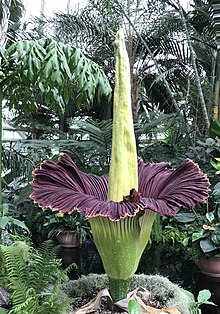
The Araceae are a family of monocotyledonous flowering plants in which flowers are borne on a type of inflorescence called a spadix. The spadix is usually accompanied by, and sometimes partially enclosed in, a spathe. Also known as the arum family, members are often colloquially known as aroids. This family of 114 genera and about 3,750 known species is most diverse in the New World tropics, although also distributed in the Old World tropics and northern temperate regions.

Amorphophallus is a large genus of some 200 tropical and subtropical tuberous herbaceous plants from the Arum family (Araceae), native to Asia, Africa, Australia and various oceanic islands. A few species are edible as "famine foods" after careful preparation to remove irritating chemicals. The genus includes the Titan arum of Indonesia, which has the largest inflorescence of any plant in the genus, and is also known as the 'corpse flower' for the pungent odour it produces during its flowering period, which can take up to seven years of growth before it occurs.

In botany, a spadix is a type of inflorescence having small flowers borne on a fleshy stem. Spadices are typical of the family Araceae, the arums or aroids. The spadix is typically surrounded by a leaf-like curved bract known as a spathe. For example, the "flower" of the well known Anthurium spp. is a typical spadix with a large colorful spathe.

Philodendron is a large genus of flowering plants in the family Araceae. As of June 2013, the Plants of the World Online accepted 621 species; other sources accept different numbers. Regardless of number of species, the genus is the second-largest member of the family Araceae, after genus Anthurium. Taxonomically, the genus Philodendron is still poorly known, with many undescribed species. Many are grown as ornamental and indoor plants. The name derives from the Greek words philo- 'love, affection' and dendron 'tree'. The generic name, Philodendron, is often used as the English name.

In botany, a bract is a modified or specialized leaf, especially one associated with a reproductive structure such as a flower, inflorescence axis, or cone scale.
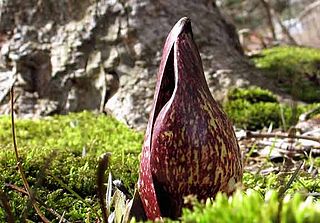
Symplocarpus foetidus, commonly known as skunk cabbage or eastern skunk cabbage, is a low-growing plant that grows in wetlands and moist hill slopes of eastern North America. Bruised leaves present an odor reminiscent of skunk.

Arum maculatum, commonly known as cuckoopint, jack-in-the-pulpit and other names, is a woodland flowering plant species in the family Araceae. It is native across most of Europe, as well as Eastern Turkey and the Caucasus.

Zantedeschia is a genus of eight species of herbaceous, perennial, flowering plants in the aroid family, Araceae, native to southern Africa(from South Africa northeast to Malawi). The genus has been introduced, in some form, on every continent.

Zoophily, or zoogamy, is a form of pollination whereby pollen is transferred by animals, usually by invertebrates but in some cases vertebrates, particularly birds and bats, but also by other animals. Zoophilous species frequently have evolved mechanisms to make themselves more appealing to the particular type of pollinator, e.g. brightly colored or scented flowers, nectar, and appealing shapes and patterns. These plant-animal relationships are often mutually beneficial because of the food source provided in exchange for pollination.
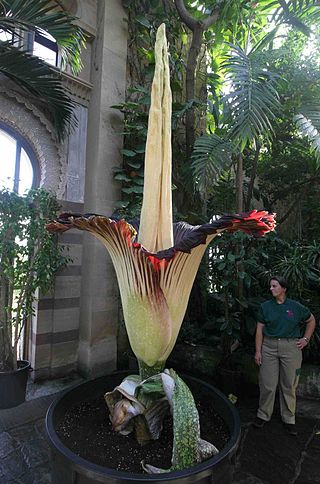
Carrion flowers, also known as corpse flowers or stinking flowers, are mimetic flowers that emit an odor that smells like rotting flesh. Apart from the scent, carrion flowers often display additional characteristics that contribute to the mimesis of a decaying corpse. These include their specific coloration, the presence of setae and orifice-like flower architecture. Carrion flowers attract mostly scavenging flies and beetles as pollinators. Some species may trap the insects temporarily to ensure the gathering and transfer of pollen.

Arum is a genus of flowering plants in the family Araceae, native to Europe, northern Africa, and western and central Asia, with the highest species diversity in the Mediterranean region. Frequently called arum lilies, they are not closely related to the true lilies Lilium. Plants in closely related Zantedeschia are also called "arum lilies".

Corypha umbraculifera, the talipot palm, is a species of palm native to eastern and southern India and Sri Lanka. It is also grown in Cambodia, Myanmar, Thailand, Mauritius and the Andaman Islands. It is one of the five accepted species in the genus Corypha. It is a flowering plant with the largest inflorescence in the world. It lives up to 60 years before bearing flowers and fruits. It dies shortly after.

Sauromatum venosum is a species of plant in the arum family, Araceae. It is native to Asia and Africa, where it grows in forests and riparian meadows.

Amorphophallus paeoniifolius, the elephant foot yam or whitespot giant arum, is a tropical plant native to Island Southeast Asia. It is cultivated for its edible tubers in Southeast Asia, South Asia, Madagascar, New Guinea, and the Pacific islands. Because of its production potential and popularity as a vegetable in various cuisines, it can be raised as a cash crop.
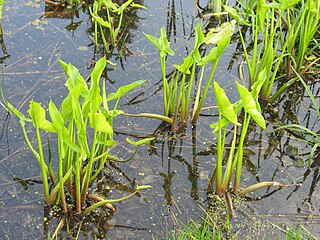
Peltandra virginica is a plant of the arum family known as green arrow arum and tuckahoe. It is widely distributed in wetlands in the eastern United States, as well as in Quebec, Ontario, and Cuba. It is common in central Florida including the Everglades and along the Gulf Coast. Its rhizomes are tolerant to low oxygen levels found in wetland soils. It can be found elsewhere in North America as an introduced species and often an invasive plant.
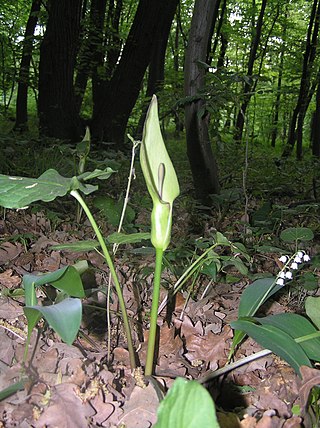
Arum cylindraceum is a woodland plant species of the family Araceae. It is found in most of Europe except the UK, Russia, Ukraine, Belarus, the Baltic States and Scandinavia, and in Turkey. It is also missing in northwestern France and southern Italy.

Arum orientale is a woodland plant species of the family Araceae. It is found in southeastern Europe as far west as Vienna and in Turkey. Its primary range is Romania, Bulgaria, and southern Ukraine.
Amorphophallus gigas is a plant in the Arum, or Calla Lily, Family, (Araceae) native to Sumatra. It is also known as Amorphophallus brooksii. It resembles its near relative Amorphophallus titanum in having a very large spadix surrounded by a very large spathe. In both species the inflorescence can be up to 11 ft 4 in in height, has the smell of rotting flesh, and is fly pollinated. According to Bown, the record specimen was 4.36 meters in height, of which 1.5 meters was the spadix. The tuber, a corm, is second in size only to A. titanum at up to 70 kilograms in weight.

Dracontium gigas is an herbaceous rainforest plant of the calla family (Araceae), native to Central America. It resembles the Old World species Amorphophallus titanum but has a spadix that is shorter than the spathe, with a somewhat smaller inflorescence up to 34 in (86 cm) in height. The leaf is up to 11.5 ft (3.5 m) high by up to 8 ft (2.4 m) wide. The petiole of A. titanum can be 12 or more inches thick, but that of D. gigas is only 2 to 3 inches in thickness.
